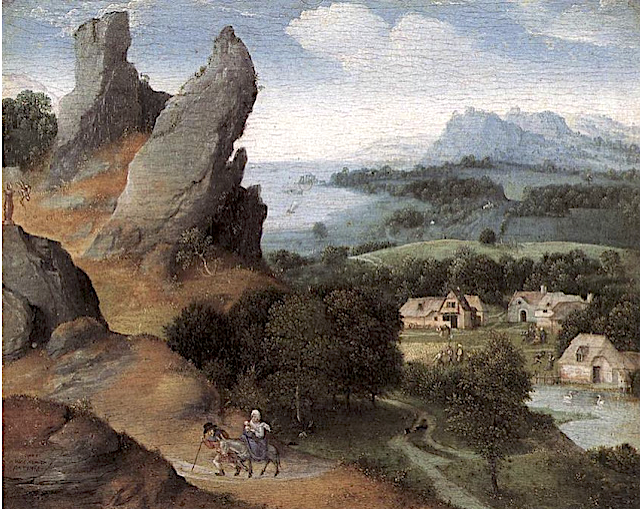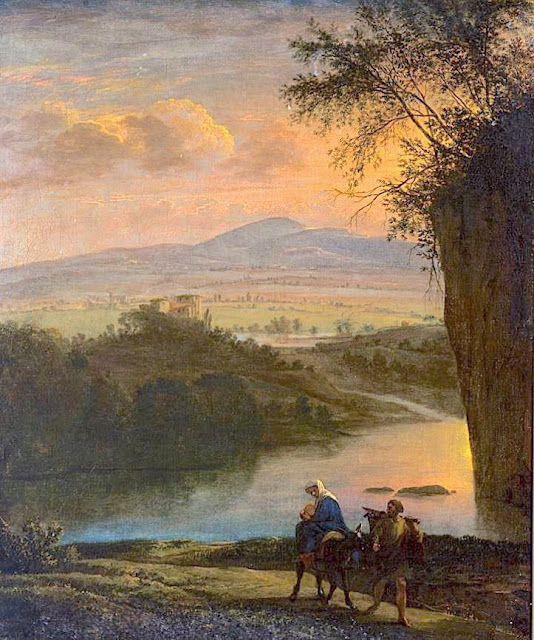DAVID ROBERTS ( 1796-1864)
Mont Sinaï / Jabal Musa (2,285 m)
Egypte
In " Ascent of the Lower Range of Sinai, February 18th 1839" , Lithographie de Louis Hague, 1849
Le mont Sinaï (2 285 m ou Jabal Mūsā ou Gabal Mūsā (en arabe : "Montagne de Moïse" ou "Mont Moïse"), également connu sous le nom de Mont Horeb ou Jebel Musa (une montagne du même nom au Maroc), est une montagne dans la péninsule du Sinaï en Égypte. Elle est considérée comme l'emplacement le plus probable du mont Sinaï ,la montagne sacrée décrite dans la Bible. Ce dernier est mentionné à plusieurs reprises dans le Livre de l'Exode (et d'autres livres de la Bible) ainsi que dans le Coran. Selon la tradition juive, chrétienne et islamique, le mont Sinaï est le lieu où Moïse a reçu les Dix Commandements, les Tables de la Loi.
Le mont Sinaï est une montagne modérément élevée près de la ville de Saint Katherine dans la région du Sinaï. Il est situé juste à côté du mont Katherine (2 629 m - 8 625 pieds), le plus haut sommet d'Égypte.
Les roches du mont Sinaï se sont formées à la fin de l'évolution du bouclier arabo-nubien (ANS). Le mont Sinaï présente un complexe annulaire composé de granites alcalins pénétrés dans divers types de roches, y compris des roches volcaniques. Les granites varient en composition du syénogranite au granit de feldspath alcalin. Les roches volcaniques sont alcalines à hyperalcalines et elles sont représentées par des coulées et des éruptions subaériennes et du porphyre subvolcanique. En général, la nature des roches exposées du mont Sinaï indique qu'elles proviennent de profondeurs différentes.
Il y a deux routes principales vers le sommet. La route la plus longue et la moins profonde, Siket El Bashait, prend environ 2, heures et demi à pied, bien que des chameaux puissent être utilisés. La route la plus raide et la plus directe (Siket Sayidna Musa) monte les 3 750 "marches de pénitence" dans le ravin derrière le monastère.
Le sommet de la montagne comporte une mosquée qui est encore utilisée par les musulmans. Il possède également une chapelle orthodoxe grecque, construite en 1934 sur les ruines d'une église du 16e siècle, qui n'est pas ouverte au public. La chapelle renferme le rocher qui est considéré comme l'endroit où furent remise à Moïse, les Tables de la Loi. Au sommet se trouve également la "Grotte de Moïse", où Moïse aurait attendu avant de recevoir les Dix Commandements.
Son travail commence à être connu et apprécié. En 1824, il rencontre Charles Dickens qui le prend en sympathie et l’introduit dans le monde. Il fait la connaissance de William Turner qui lui conseille de voyager : « c’est à l’étranger qu’on apprend la peinture ». La peinture l’attire et il commence ses voyages
Il quitte Londres en août 1838, traverse la France, embarque à Marseille et parvient à Alexandrie, après une escale à Malte le 24 septembre. Il se rend immédiatement au Caire et il loue un bateau avec douze hommes d’équipage pour remonter le Nil. Il parvient à l’extrême Sud de son voyage, à Abou Simbel, en Nubie le 8 novembre. À l’aller comme au retour, il fait une grande quantité de dessins et d’aquarelles des grands sites égyptiens. La grande surprise vient de la taille gigantesque des monuments. Il ne manque pas de dessiner des personnages devant pour montrer l'échelle. Il note dans son journal « Nous sommes un peuple de nains visitant une nation de géants ». Certains temples sont encore ensablés quand il les dessine. L’ensablement était une méthode de construction. N’ayant pas de moyens de levage, on construisait des rampes de sable, pour monter les pierres sur des rondins, jusqu’à les poser sur les pierres précédentes. À la fin de la construction, on désensablait le temple et il apparaissait alors dans sa taille impressionnante. Le temple d’Edfou est un exemple de cet ensablement. Les vents de sable, depuis l’Antiquité ont aussi une part de responsabilité dans cet ensablement, l’extérieur du temple d’Abou Simbel en est un autre exemple.
Il revient au Caire le 21 décembre avec plus de cent dessins et aquarelles, et séjourne là jusqu’à son départ en Terre Sainte. Introduit dans le milieu arabe, il fait de nombreux croquis et aquarelles au Caire, y compris dans les mosquées.
Il écrit : « Je suis le premier artiste, du moins anglais, à être venu ici. Les travaux des Français ne donnent pas l’impression de ces vestiges admirables comme je le sais maintenant »
Avec deux compagnons anglais, il part pour la Terre Sainte le 7 février 1839. Ils sont accompagnés de cinq serviteurs armés. Ils portent tous un costume local et sont portés par des chameaux. Ils vont jusqu’à Baalbek, mais il tombe malade et décide le 8 mai de repartir pour Beyrouth, puis de gagner Alexandrie et revenir en Angleterre
Il arrive à Londres, après deux escales, à Malte et Gibraltar, le 21 juillet 1839. Il montre ses œuvres originales, en obtient un grand succès et il est élu membre de la Royal Academy (RA) le 10 février 1841.
Il se met ensuite au travail avec Louis Haghe pour son grand œuvre, un recueil de 247 lithographies, gravées par son ami Louis Hague, d’après ses croquis et aquarelles. Louis Hague est le fils d’un architecte et il a appris la gravure. Mais l’influence de son père est notable, les lithographies doivent beaucoup aux rendus des dessins d’architecture. Le trait a beaucoup d’importance et les œuvres ressemblent à des gravures aquarellées.
2024 - Gravir les montagnes en peinture
Un blog de Francis Rousseau
%20pub.%201849%20(litho),%20Roberts,%20David%20(1796-1864)%20(after).png)














